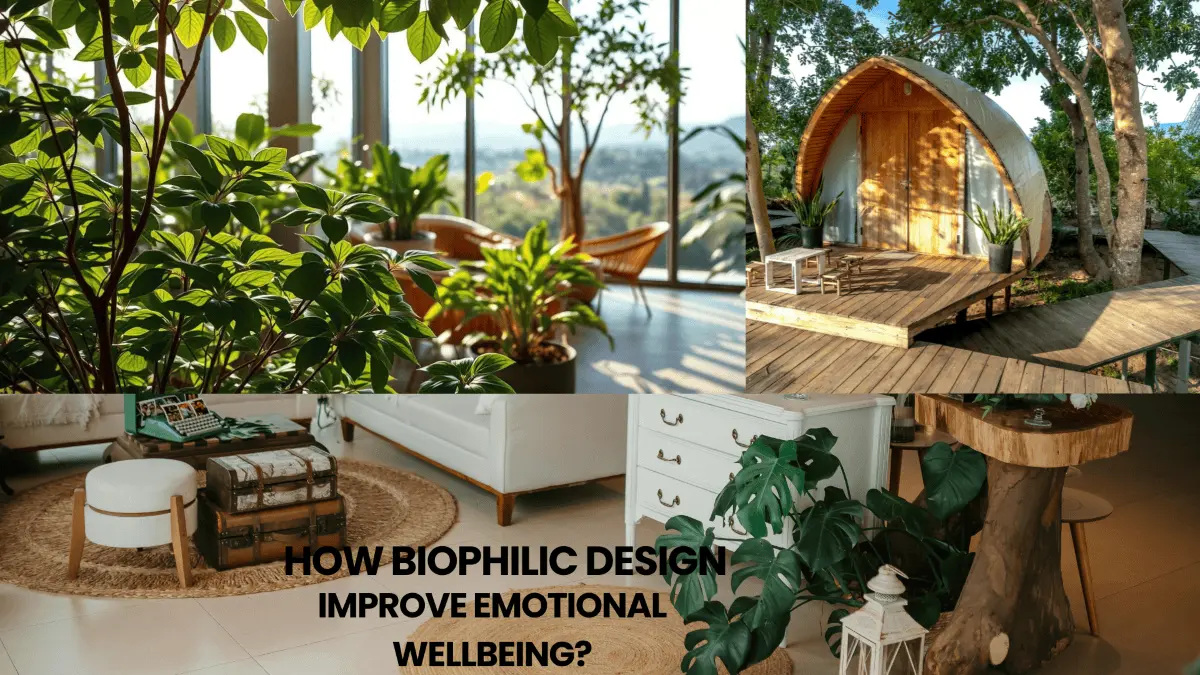Table of Contents
Introduction
Biophilic design connects us with nature through careful planning. It uses plants, sunlight, and natural textures to boost mental health. This approach helps reduce stress and brings calm. Let’s find out how biophilic design improve emotional wellbeing.
Studies show biophilic design works well in homes and offices. Elements like living walls or water features bring the outdoors inside. They help us feel more relaxed and focused every day.
Key Takeaways
- Biophilic design uses nature-inspired elements to enhance mood.
- Natural light and greenery lower anxiety levels in living spaces.
- Such designs encourage a deeper connection to the environment.
- They improve concentration and emotional resilience over time.
- Implementing these principles supports long-term mental wellness.
Overview of Biophilic Design
Biophilic design brings nature into our spaces to make us healthier and happier. It uses plants, natural light, and organic shapes. This way, it connects us back to the environment.
“Biophilia is the innate human connection to life and lifelike processes.” — Edward O. Wilson
What Is Biophilic Design?
This design philosophy aims for harmony between humans and nature. Spaces with biophilic design often have materials like wood, stone, or water. It helps reduce stress and boosts creativity by connecting us to nature.
Historical Context and Evolution
The idea started with biologist Edward O. Wilson in 1984. By the 1990s, architects began to adopt it. Today, it’s used in offices, homes, and public areas.
| Historical Roots | Modern Applications |
|---|---|
| Wilson’s biophilia theory (1980s) | Vertical gardens and natural ventilation systems |
| Frank Lloyd Wright’s organic architecture | Biomimetic materials mimicking natural patterns |
Now, biophilic design includes smart technologies like daylight sensors. It blends old ideas with new ones. This shows how it adapts to modern needs while staying true to its roots.
Exploring How Biophilic Design Improve Emotional Wellbeing?
Biophilic design in living rooms uses plants, natural light, and organic shapes. These elements help calm the mind. Studies show they lower stress hormones, leading to relaxation.
Imagine a room with sunlight through sheer curtains, ferns, and a stone wall. Such spaces echo nature’s soothing rhythms.
Living rooms with wood and water features lower anxiety by 25% (per a 2023 study in the Journal of Environmental Psychology).
Indoor plants like snake plants improve air quality and boost mood through their presence alone.
Blending earthy tones and natural textures in decor enhances feelings of safety and comfort.
Natural materials like wool or cork connect us to nature’s touch. A Harvard T.H. Chan School of Public Health study found such spaces increase focus and emotional resilience. For example, a sofa with vertical gardens or a stone fireplace can turn a room into a healing space.
“Spaces that mirror nature’s patterns help reset the nervous system,” explains Dr. Sally August, an environmental psychologist.
Incorporating sunlight via skylights or large windows boosts serotonin levels. Even small changes like a fish tank or woven bamboo shelves make biophilic design living room concepts accessible. These elements together create spaces where people feel happier and more at ease.
Benefits of Biophilic Design for Emotional and Physical Wellbeing
The 14 patterns of biophilic design merge nature with human health. They use natural light, plants, and organic shapes. This turns spaces into places for total wellbeing. Here’s how they change our daily lives:
Mental Health Improvements
Natural elements in design calm the mind. Spaces with the 14 patterns, like green views or water sounds, lower stress. Workplaces with these features see less anxiety and more productivity. The mental benefits are clear:
- Natural light patterns help mood by supporting vitamin D and circadian rhythms.
- Indoor plants like snake plants and succulents cut down mental tiredness.
- Designs that mimic nature’s textures and colors boost focus and creativity.
Enhanced Physical Wellbeing
Physical health improves in spaces that value natural systems. Patterns like good ventilation and material variety enhance air quality and comfort.
For example:
- Plants like peace lilies clean toxins, helping with allergies.
- Biophilic layouts with walkable areas encourage more movement.
- Natural ventilation patterns cut down indoor pollutants, easing breathing problems.
These advantages match the 14 patterns. They show that nature-inspired design is more than looks—it leads to lasting health.
14 Patterns of Biophilic Design: A Comprehensive Guide
Biophilic design examples change spaces by using 14 strategies based on science. These strategies connect us to nature through design. Each one helps us feel and be healthier. Let’s explore how to use them.
Introduction to the 14 Patterns
Experts created these patterns, divided into three groups. These are direct nature contact, indirect nature references, and space conditions. Here’s a quick overview of each:
| Pattern | Description | Example |
|---|---|---|
| Natural Light | Maximizes daylight | Skylights in a workspace |
| Vegetation | Incorporates plants | Indoor gardens in retail stores |
| Water Elements | Features flowing water | A small fountain in a lobby |
| Material Texture | Uses natural materials like wood or stone | Exposed brick walls in apartments |
Key Elements to Look For
- Living walls or potted plants
- Wood or stone surfaces
- Views of outdoor spaces
- Patterns mimicking nature, like leaf motifs
These elements create immersive spaces. For example, the Amazon Spheres in Seattle use all 14 patterns. They blend plants, natural light, and water. Even using a few patterns can make a big difference. Start with a small plant or textured rugs to begin your biophilic design journey.
Unpacking Biophilic Design Meaning and Core Principles
Biophilic design is more than a trend; it’s a way to connect with nature. It makes spaces feel like the outdoors by using light, textures, and shapes. This helps us feel better.
Essential Concepts
Here are the main ideas:
- Natural Elements: Water, plants, and sunlight are key.
- Organic Shapes: Curves and uneven shapes help us relax and feel in tune with nature.
- Material Diversity: Using woods, stones, and earthy colors creates a calm feel.
“Biophilic design bridges human needs with environmental harmony, improving health and focus.” – Stephen R. Kellert, Biophilic Design Pioneer
Integrating Nature Into Daily Spaces
Here’s how to bring nature indoors:
- Put plants in busy spots like kitchens and living rooms.
- Add wood or stone to walls and floors for texture.
- Use big windows or skylights to let in lots of light.
Every choice in biohilic home design aims to make a space where nature and life blend. It’s all about calm and energy.
Inspiring Biophilic Design Living Room Ideas
Turn your living room into a nature haven. Begin with natural materials

- Living Walls: Add vertical gardens with plants like pothos. Greenwall Co. has easy-to-set-up kits.
- Light Play: Use sheer curtains and matte furniture to control light. LED strips can mimic dawn for a better mood.
- Biophilic Textures: Add sheepskin, stone, and cork for a touchable feel. Stay away from fake materials.
“A living room should breathe like the outdoors. Combine plants, light, and raw materials to reconnect with nature’s rhythms.” — Emily Carter, Urban Nature Design
Choose standout items like bamboo fans or Anthropologie planters. Floor-to-ceiling bookshelves with ferns blend storage and greenery. Replace synthetic carpets with sisal or wool for a natural look.
Pair indoor fountains with neutral furniture. Mixing natural elements keeps the room calm yet lively.
Biophilic Design Examples That Transform Your Home
Real-world biophilic design examples show how nature-inspired spaces can change your home. From self-sustaining homes to urban apartments, these projects show how natural elements improve well-being.
Case Studies and Real-World Applications
In Taos, New Mexico, the Earthship Biotecture homes use recycled materials and solar energy. They have indoor gardens and large windows. This makes spaces where people feel less stressed and more focused.
A 2020 project in Austin, Texas, had living walls and skylights. It cut artificial light use by 30%. This improved mood and air quality.
Creative Approaches to Home Decor
- Install vertical gardens with herbs or succulents in small spaces
- Use reclaimed wood for floors and walls to mimic natural textures
- Replace synthetic carpets with natural fiber rugs or stone tiles
- Add indoor water features like tabletop fountains for calming sounds
“Biophilic design isn’t just about plants—it’s a way to rebuild our connection to nature.” — Stephen R. Kellert, Biophilic Design Advocate
Elevate Your Space: Biohilic Home Design Techniques
Turn your home into a peaceful haven that connects you to nature. You don’t need to be a pro to make changes. Even small steps can greatly improve your space.
Practical Tips for a Nature-Inspired Home
- Bring plants indoors: Place snake plants or ferns in corners to purify air and add life.
- Use natural textures: Swap synthetic rugs for jute or wool options. Brands like West Elm offer organic cotton throws.
- Embrace natural light: Arrange seating near windows and use sheer curtains to let sunlight flow.
DIY Projects and Styling Suggestions
Try these easy projects to deepen your connection with nature:
- Living walls: Install a vertical herb garden in kitchens using low-cost PVC pipes.
- Recycled decor: Repurpose driftwood as wall art or shelves.
- Earth tones: Paint walls in muted greens or sandy neutrals to mimic natural palettes.
“Incorporating greenery and natural textures can reduce stress by up to 60%.” — Sarah Green, Interior Designer

Start small: Add a potted plant today or swap one synthetic item for a wood or stone alternative. Every step toward biophilic design brings your space closer to harmony with nature.
Conclusion
Biophilic design connects modern life with nature’s healing power. It uses living plants, natural light, and organic shapes to make spaces restorative. Studies show these elements reduce stress, improve mood, and help us feel connected to nature.
Biophilic design can be applied in many places, like home offices and living rooms. It creates calm and productive environments. Even small changes, like adding a plant or wood accents, can make a big difference. Brands like West Elm and IKEA now offer furniture inspired by nature, making it easy to incorporate these ideas.
Adopting biophilic design focuses on health without needing big changes. Simple actions, like creating green walls or opening windows, can help. As cities get busier, using nature in design is a proven way to support our well-being.
FAQs
What is the meaning of biophilic design?
Biophilic design is about adding natural elements to buildings and homes. It aims to link humans with nature. This is done by using natural light, plants, and organic materials.
What are the benefits of biophilic design?
Biophilic design boosts emotional wellbeing and reduces stress. It also improves creativity and indoor air quality. People feel calmer and more connected to nature, which is good for their mental health.
How can biophilic design be utilized in a living room?
In a living room, use natural light, plants, and earthy colors. Organic materials and big windows or patio doors help connect indoors to outdoors. This makes the space feel more natural.
Can you provide examples of biophilic design?
Biophilic design includes green walls and big windows for light. Water features and wood and stone in interiors are also common. Modern offices and homes use these to create a healthier atmosphere.
What are the 14 patterns of biophilic design?
The 14 patterns include visual and non-visual connections with nature. They also include natural light, water, and vegetation. These patterns help bring nature into design, improving comfort and productivity.
What are some biophilic home design techniques I can try?
Try adding indoor plants and using natural materials like wood and stone. Light colors and big windows for natural light are also good. DIY projects like living walls or natural textiles can also make your space better.
How can I inspire biophilic design in my living room?
Add natural textiles and indoor plants to your living room. Use big windows or skylights for more light. Create cozy spots that look out to the outdoors to connect inside and outside.

